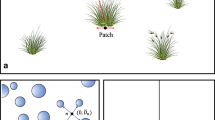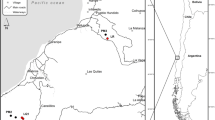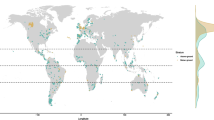Abstract
Understanding how biodiversity responds to fine-scale heterogeneity improves our ability to predict larger-scale diversity patterns and informs local-scale conservation practices. This information is important in the design of conservation set-asides in commercial forestry landscapes in the Maputaland-Pondoland-Albany biodiversity hotspot, in South Africa. We assessed how soil arthropod assemblages vary among biotopes with varying degrees of contrast in forestry landscape mosaics in this hotspot. The biotopes included dry and hydromorphic grasslands, indigenous forests and pine plantations. Assemblages were highly segregated among all biotopes for overall arthropods, and for all the feeding guilds, namely predators, herbivores, detritivores, and omnivores. There was a high degree of assemblage dissimilarity between structurally contrasting biotopes (grasslands vs. wooded biotopes) and biotopes that differ in their degree of transformation (natural biotopes vs. plantations). Yet, there was an equally high level of assemblage dissimilarity between dry and hydromorphic grasslands, which are similar in structure and undergo the same disturbance regimes, which emphasises the responsiveness of soil fauna to fine-scale habitat heterogeneity. Different biotopes favoured different feeding guilds and each biotope had species strongly associated with it, highlighting the complementarity of the biotopes. All natural biotopes had relatively high species richness, diversity, and species turnover. The diversity and turnover in pine plantations was as high as in the natural areas, suggesting that plantation conditions may favour certain soil arthropods.
Current delineation of conservation areas in timber estates that prioritize biodiversity-rich dry grasslands, wetlands and indigenous forests, greatly benefit soil arthropods. Approaches that promote a mix of biotopes in conservation areas and having biotopes represented across different landscapes would further maximize local heterogeneity and landscape-scale soil arthropod biodiversity.



Similar content being viewed by others
References
Andersen AN (2019) Responses of ant communities to disturbance: five principles for understanding the disturbance dynamics of a globally dominant faunal group. J Anim Ecol 88:350–362. https://doi.org/10.1111/1365-2656.12907
Attignon SE, Weibel D, Lachat T, Sinsin B, Nagel P, Peveling R (2004) Leaf litter breakdown in natural and plantation forests of the Lama forest reserve in Benin. Appl Soil Ecol 27:109–124. https://doi.org/10.1016/j.apsoil.2004.05.003
Barrios E (2007) Soil biota, ecosystem services and land productivity. Ecol Econ 64:269–285. https://doi.org/10.1016/j.ecolecon.2007.03.004
Barton PS, Manning AD, Gibb H, Lindenmayer DB, Cunningham SA (2010) Fine-scale heterogeneity in beetle assemblages under co-occurring Eucalyptus in the same subgenus. J Biogeogr 37:1927–1937. https://doi.org/10.1111/j.1365-2699.2010.02349.x
Baselga A, Orme CDL (2012) Betapart: an R package for the study of beta diversity. Methods in Ecol Evol 3:808–812. https://doi.org/10.1111/j.2041-210X.2012.00224.x
Bates D, Maechler M, Bolker B, Walker S (2014) lme4: Linear mixed-effects models using Eigen and S4. R package version 1:1–23. https://doi.org/10.48550/arXiv.1406.5823
Batzer D, Wu H (2020) Ecology of Terrestrial Arthropods in Freshwater Wetlands. Annu Rev Entomol 65:101–119. https://doi.org/10.1146/annurev-ento-011019-024902
Bjornstad ON (2020) ncf: Spatial covariance functions. R package version 1.2- 9. https://cran.r-project.org/web/packages/ncf/ncf.pdf. Accessed June 2022
Cadman M, deVilliers C, Lechmere-Oertel R, McCulloch D (2013) Grasslands ecosystem guidelines: Landscape interpretation for planners and managers. South African National Biodiversity Institute, Pretoria
CEPF (Critical Ecosystem Partnership Fund) (2010) Ecosystem profile. Maputaland-Pondoland-Albany biodiversity hotspot. Conservation International Southern African Hotspots Programme, Cape Town
De Caceres M, Legendre P (2009) Associations between species and groups of sites: indices and statistical inference. Ecology 90:3566–3574. https://doi.org/10.1890/08-1823.1
de Vries JPR, Koma Z, WallisDeVries MF, Kissling WD (2021) Identifying fine-scale habitat preferences of threatened butterflies using airborne laser scanning. Divers Distrib 27:1251–1264. https://doi.org/10.1111/ddi.13272
Dippenaar-Schoeman AS, Harvey MS (2000) A check list of the pseudoscorpions of South Africa (Arachnida: Pseudoscorpiones). Koedoe 43:89–102. https://doi.org/10.4102/koedoe.v43i2.201
Dirsh VM (1965) The african genera of Acridoidea. Cambridge University Press, London
Eckert M, Gaigher R, Pryke JS, Samways MJ (2019) Rapid recovery of soil arthropod assemblages after exotic plantation tree removal from hydromorphic soils in a grassland-timber production mosaic. Restor Ecol 27:1357–1368. https://doi.org/10.1111/rec.12991
Eckert M, Gaigher R, Pryke JS, Samways MJ (2022) Conservation of complementary habitat types and small-scale spatial heterogeneity enhance soil arthropod diversity. J Environ Manage 317:115482. https://doi.org/10.1016/j.jenvman.2022.115482
Foord SH, Ferguson JWH, van Jaarsveld AS (2003) Coleopteran assemblages in afromontane grasslands reflect fine-scale variation in vegetation. Environ Entomol 32:797–806. https://doi.org/10.1603/0046-225x-32.4.797
Forestry South Africa (2021) Environmental Guidelines for Commercial Forestry Plantations in South Africa. Available at: https://www.forestrysouthafrica.co.za/wp-content/uploads/2021/06/ENVIRONMENTAL-GUIDELINES-2021-June-email.pdf (accessed December 2022)
Gaigher R, Pryke JS, Samways MJ (2021) Habitat complementarity and butterfly traits are essential considerations when mitigating the effects of exotic plantation forestry. Biodivers Conserv 30:4089–4109. https://doi.org/10.1007/s10531-021-02293-6
Greenslade PJM (1973) Sampling ants with pitfall traps: digging in effects. Insectes Soc 20:343–353. https://doi.org/10.1007/BF02226087
Haddad CR, Dippenaar-Schoeman AS, Wesolowska W (2006) A checklist of the non-acarine arachnids (Chelicerata: Arachnida) of the Ndumo Game Reserve, Maputaland, South Africa. Koedoe 49:1–22. https://doi.org/10.4102/koedoe.v49i2.116
Hothorn T, Bretz F, Westfall P (2008) Simultaneous inference in general parametric models. Biom J 50:346–363. https://doi.org/10.1002/bimj.200810425
Hsieh TC, Ma KH, Chao A(2020) iNEXT: Interpolation and extrapolation for species diversity. R package version 2.0.20. https://cran.r-project.org/web/packages/iNEXT/iNEXT.pdf. Accessed June 2022
Hui FK (2016) Boral. Bayesian ordination and regression analysis of multivariate abundance data in R. Methods Ecol Evol 7:744–750. https://doi.org/10.1111/2041-210X.12514
Hunter ML, Acuña V, Bauer DM, Bell KP, Calhoun AJK, Felipe-Lucia MR et al (2017) Conserving small natural features with large ecological roles: a synthetic overview. Biol Conserv 211:88–95. https://doi.org/10.1016/j.biocon.2016.12.020
Janion-Scheepers C, Deharveng L, Bedos A, Chown S (2015) Updated list of Collembola species currently recorded from South Africa. ZooKeys 503:55–88. https://doi.org/10.3897/zookeys.503.8966
Janion-Scheepers C, Measey JJ, Steven B, Louise LC, Jonathan C, Joanna C et al (2016) Soil biota in a megadiverse country: current knowledge and future research directions in South Africa. Pedobiologia 59:129–174. https://doi.org/10.1016/j.pedobi.2016.03.004
Joubert L, Pryke JS, Samways MJ (2016) Positive effects of burning and cattle grazing on grasshopper diversity. Insect Conserv Divers 9:290–301. https://doi.org/10.1111/icad.12166
Keep ME, Ledger JA (1990) Lice (Phthiraptera), fleas (Siphonaptera) and mites (Trombidiformes, Sarcoptiformes and Mesostigmata) recorded from the larger game species in Natal. Lammergeyer 41:23–29
Kietzka GJ, Pryke JS, Samways MJ (2021) Webs of well-designed conservation corridors maintain river ecosystem integrity and biodiversity in plantation mosaics. Biol Conserv 254:108965. https://doi.org/10.1016/j.biocon.2021.108965
Lavelle P, Decaëns T, Aubert M, Barot S, Blouin M, Bureau F et al (2006) Soil invertebrates and ecosystem services. Eur J Soil Biol 42:S3–S15. https://doi.org/10.1016/j.ejsobi.2006.10.002
Li D (2018) hillR: taxonomic, functional, and phylogenetic diversity and similarity through Hill numbers. J Open Source Softw 3:1041. https://doi.org/10.21105/joss.01041
Margules CR, Pressey RL (2000) Systematic conservation planning. Nature 405:243–253. https://doi.org/10.1038/35012251
Midega CAO, Khan ZR, Van den Berg J, Ogol CKPO, Dippenaar-Schoeman AS, Pickett JA, Wadhams LJ (2008) Response of ground-dwelling arthropods to a “push-pull” habitat management system: spiders as an indicator group. J Appl Entomol 132:248–254. https://doi.org/10.1111/j.1439-0418.2007.01260.x
Mucina L, Rutherford MC (2006) The vegetation of South Africa, Lesotho and Swaziland. South African National Biodiversity Institute, Pretoria
Neke K, Du Plessis M (2004) The threat of transformation: quantifying the vulnerability of grasslands in South Africa. Conserv Biol 18:466–477. https://doi.org/10.1111/j.1523-1739.2004.00157.x
Picker M, Griffiths C, Weaving A (2004) Field guide to insects of South Africa. Struik Nature, Cape Town
Pincebourde S, Murdock CC, Vickers M, Sears MW (2016) Fine-scale microclimatic variation can shape the responses of organisms to global change in both natural and urban environments. Integr Comp Biol 56:45–61. https://doi.org/10.1093/icb/icw016
Pryke JS, Roets F, Samways MJ (2022) Large african herbivore diversity is essential in transformed landscapes for conserving dung beetle diversity. J Appl Ecol 59:1372–1382. https://doi.org/10.1111/1365-2664.14152
Pryke JS, Samways MJ (2012a) Ecological networks act as extensions of protected areas for arthropod biodiversity conservation. J Appl Ecol 49:591–600. https://doi.org/10.1111/j.1365-2664.2012.02142.x
Pryke JS, Samways MJ (2012b) Conservation management of complex natural forest and plantation edge effects. Landsc Ecol 27:73–85. https://doi.org/10.1007/s10980-011-9668-1
Pryke SR, Samways MJ (2001) Width of grassland linkages for the conservation of butterflies in south african afforested areas. Biol Conserv 101:85–96. https://doi.org/10.1016/S0006-3207(01)00042-8
QGIS Development Team (2009) QGIS Geographic Information System. Open Source Geospatial Foundation. http://qgis.osgeo.org. Accessed March 2016
R Core Team (2016) R: A language and environment for statistical computing. R Foundation for Statistical Computing, Vienna, Austria. https://www.R-project.org. Accessed March 2016
Reyers B, Fairbanks DHK, van Jaarsveld AS, Thompson M (2001) Priority areas for the conservation of south african vegetation: a coarse-filter approach. Divers Distrib 7:79–95. https://doi.org/10.1046/j.1472-4642.2001.00098.x
Riva F, Fahrig L (2022) The disproportionately high value of small patches for biodiversity conservation. Conserv Lett 15:e12881. https://doi.org/10.1111/conl.12881
Rountree M, Batchelor L, MacKenzie J, Hoare D (2008) Updated manual for the identification and delineation of wetlands and riparian areas. Department of Water Affairs and Forestry, Pretoria
Samways MJ, Pryke JS (2015) Large-scale ecological networks do work in an ecologically complex biodiversity hotspot. Ambio 45:161–172. https://doi.org/10.1007/s13280-015-0697-x
Sandström J, Bernes C, Junninen K, Lõhmus A, Macdonald E, Müller J, Jonsson BG (2019) Impacts of dead wood manipulation on the biodiversity of temperate and boreal forests. A systematic review. J Appl Ecol 56:1770–1781. https://doi.org/10.1111/1365-2664.13395
Scholtz CH, Holm E (1985) Insects of Southern Africa. Butterworths, Cape Town
Spitzer K, Danks HV (2006) Insect biodiversity of boreal peat bogs. Annu Rev Entomol 51:137–161. https://doi.org/10.1146/annurev.ento.51.110104.151036
Steenkamp Y, Van Wyk B, Victor J, Hoare D, Smith G, Dold T et al (2004) Maputaland-Pondoland-Albany. In: Mittermeier RA, Gill PR, Hoffman M, Pilgrim JD, Brooks TM, Mittermeier CG et al (eds) Hotspots revisited: Earth’s biologically richest and most endangered ecoregions. Monterrey, Mexico, pp 219–228
Theron KJ, Pryke JS, Samways MJ (2022) Maintaining functional connectivity in grassland corridors between plantation forests promotes high-quality habitat and conserves range restricted grasshoppers. Landsc Ecol 37:2081–2097. https://doi.org/10.1007/s10980-022-01471-3
van Schalkwyk J, Gaigher R, Pryke JS, Samways MJ (2021) Corridor heterogeneity is more important than corridor design for maintaining butterfly functional and taxonomic diversity. J Appl Ecol 58:2734–2746. https://doi.org/10.1111/1365-2664.14006
Walker JB (1991) A review of the ixodid ticks (Acari: Ixodidae) occurring in southern Africa. Onderstepoort J Vet Res 58:81–105. http://hdl.handle.net/2263/41388
Wang YI, Naumann U, Wright ST, Warton DI (2012) Mvabund – an R package for model-based analysis of multivariate abundance data. Methods Ecol Evol 3:471–474. https://doi.org/10.1111/j.2041-210X.2012.00190.x
Wiescher PT, Pearce-Duvet JMC, Feener DH (2012) Assembling an ant community: species functional traits reflect environmental filtering. Oecologia 169:1063–1074. https://doi.org/10.1007/s00442-012-2262-7
Yekwayo I, Pryke JS, Roets F, Samways MJ (2017) Responses of ground living arthropods to landscape contrast and context in a forest-grassland mosaic. Biodivers Conserv 26:631–651. https://doi.org/10.1007/s10531-016-1262-z
Xing S, Hood ASC, Dial RJ, Fayle TM (2022) Species turnover in ant assemblages is greater horizontally than vertically in the world’s tallest tropical forest. Ecol Evol 12:e9158. https://doi.org/10.1002/ece3.9158
Acknowledgements
For assistance in the field, we thank J. Theron and S. Doarsamy. We also thank C. Deacon and A. Dippenaar-Schoeman for assisting with the identification of specimens. We thank Mondi Group for financial and technical support, and permitting sampling on their property. We also thank Ezemvelo KZN Wildlife for granting sampling permits and the support staff at the Department of Conservation Ecology and Entomology of Stellenbosch University.
Author information
Authors and Affiliations
Contributions
All authors contributed to the design of the study. M.E. collected data for the study. M.E. and J.S.P. performed statistical analyses. M.E., R.G. and J.S.P. wrote the manuscript. All authors reviewed the manuscript.
Corresponding author
Ethics declarations
Competing interests
The authors declare no competing interests.
Additional information
Publisher’s Note
Springer Nature remains neutral with regard to jurisdictional claims in published maps and institutional affiliations.
Electronic supplementary material
Below is the link to the electronic supplementary material.
Rights and permissions
Springer Nature or its licensor (e.g. a society or other partner) holds exclusive rights to this article under a publishing agreement with the author(s) or other rightsholder(s); author self-archiving of the accepted manuscript version of this article is solely governed by the terms of such publishing agreement and applicable law.
About this article
Cite this article
Eckert, M., Gaigher, R., Pryke, J. et al. Soil arthropod assemblages reflect both coarse- and fine-scale differences among biotopes in a biodiversity hotspot. J Insect Conserv 27, 155–166 (2023). https://doi.org/10.1007/s10841-022-00449-5
Received:
Accepted:
Published:
Issue Date:
DOI: https://doi.org/10.1007/s10841-022-00449-5




